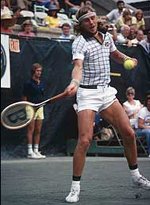
Due to incredible advancements in racket and string technology, along with the "topspin revolution" initiated by Bjorn Borg, forehand technique has changed dramatically over the past two decades. Over the years, players have improved upon Borg's forehand, culminating in a modern forehand that is both extraordinarly powerful as well as extremely consistent due to heavy topspin.
Unlike the long, linear, arms swings of the 70's (straight back backswing and finish with your racket pointing towards your target), modern technique taps into two forms of angular momentum. First we have the coiling and uncoiling of the upper body to create a kinetic chain where energy flows from the legs and uncoiling torso all the way into the second burst of angular moment, where the racket travels "inside out" into contact through a relaxation of the wrist.
The "swing" of the arm has been eliminated. Instead the arm gets pulled forward rather rather than "swung." By opening the shoulders first and then pulling the racket, butt cap first, you create lag. And by pulling the butt of the racket to the ball, you are able to contact the ball in a perfectly leveraged position which is in front of the body and to the side (at a 45 degree angle) with the shoulder powerfully positioned behind the hand.
On contact, instead of "hitting through the ball" or "extending to the target", the modern forehand has you powerfully, and muscularly lift the arm and racket. By lifting upward, you get your arm, shoulder, and hand all working together to powerfully bite into, and lift the ball. The actual "hit" has much more in common with a boxing upper cut motion where the shoulder, elbow and hand drive upward. You can see this most clearly in the "reverse forehand" or "buggy whip forehand" that is so popular today where the hand finishes on the right side of the body with the hand behind the head. Watch it here in incredible detail This upward thrust of the shoulder and hand creates a stroke that is much more powerful and explosive.
In the Olivier Rochus animation (as well as in the James Blake animation) on the right, focus on the how they drive their upper arms upward on contact. In that brief moment from contact to just after contact they are driving upward from the palm of the hand through the arm to the powerful shoulder. This is very different than "hitting through" the ball. I would call it a powerful push and drive upward of the arm, hand, and shoulder.
The standard grip to hit this type of forehand is the semi-western or "frying pan" grip. This grip positions the hand more under the handle rather than behind it. By having the palm positioned more under the handle it aids in the upward lifting of the ball with the arm and shoulder.


